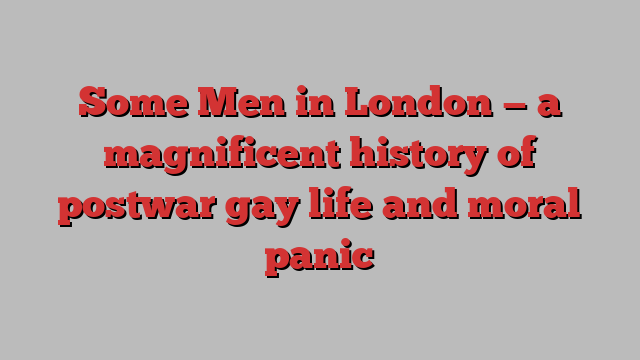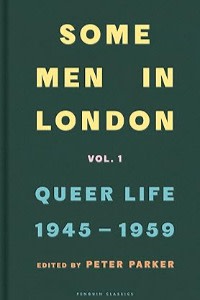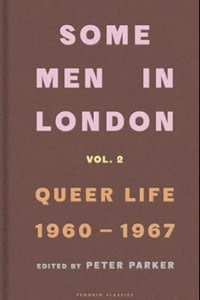
On Monday May 7 1945, news of Germany’s surrender spread through the London streets. “Gaiety began to invade people at about 3pm,” John S Barrington, a physique photographer, wrote in his diary. By 11pm, the West End was ablaze with celebrations, and Barrington was pushing through the crowds, “kissing every soldier, sailor and airman I could meet”, one of whom he took back to his office: an “exceptional” experience for them both. The revels continued on through the next day, and by the early hours of May 9, the streets around Piccadilly were a hotbed of sexual abandon: heterosexual couples oblivious to passers-by, and “sailors and kneeling men” in dark doorways, alleys and phone boxes.
Barrington’s escapades are the bold opening gambit of Peter Parker’s magnificent two-volume anthology charting gay life from the end of the second world war through to the eventual partial decriminalisation of homosexual acts in the UK in 1967. It combines material from both the public and private record for each year in question: 700-odd pages of choice cuttings from newspapers, police reports and court records, extracts from diaries, intimate correspondence and contemporary fiction.
“The war broke down inhibitions and the element of danger made sex rampant,” novelist Rodney Garland wrote in The Heart in Exile (1953), a detective story in which a psychiatrist investigates the suicide of his ex-lover. “Public opinion was lax and the understaffed police had many other things on their hands.”
The aftermath, though, was a different story. People wanted convention and order restored but, at the same time, society was in flux. Women had gained considerable freedoms, youth culture was in the ascendancy, and traditional class hierarchies were breaking down, all of which led to scaremongering about the nation’s moral decline. London earned a reputation as a hotbed of “vice”, rife with “thugs”, “tarts” and “pansies”.
All were demonised by the press, but the latter were also hunted down in the streets. Legions of plain-clothes police officers were deployed as honey traps in known gay pick-up spots. (Back at their stations, they kept scoreboards of their arrests, vying for the highest numbers.) “One is forced to wonder whether there are some policemen who are more concerned to provoke crime than to prevent it,” A Hallidie Smith, secretary of the Homosexual Law Reform Society, disdainfully wrote in correspondence printed in The New Statesman in 1959.

Some Men in London animates mid-century gay life with panoramic, surround-sound effect, while its collage-like form makes for easily digestible reading. If you think you already know this period, think again; which is also my advice if you think this book has little to interest you. One war was over, but during this two-decade period, England — and at its heart, London — became a battleground in a new conflict as gay men fought for their lives and their dignity. To overlook or ignore this is to miss one of the most significant shifts in the postwar cultural landscape.
A running theme is gay men being pilloried as a threat. As “corrupters” of young men, but also as a “dirty-minded danger to the virile manhood of this country”, as MP Godfrey Lagden put it in a 1960 House of Commons debate. His words echoed the hysteria of fellow Tory Earl Winterton’s accusation, six years earlier in the Lords, that “few things lower the prestige, weaken the moral fibre and injure the physique of a nation more than tolerated and widespread homosexualism”.
As Carl Winter, director of the Fitzwilliam Museum in Cambridge, acutely noted, gay men were seen as a particular threat to society because they bucked “ordinary social prejudices and distinctions”. It was quite possible, he added, “that a peer may be attached to a farm labourer or an able seaman to a university professor”.
Winter’s comments were recorded (under a protective pseudonym) in the 1957 Wolfenden Report by a government-appointed committee tasked with inquiring into the legality of homosexuality and prostitution. Homosexual activity between men had been illegal in Britain since 1885, but the sharp postwar rise in arrests and prosecutions was a problem, especially when high-profile individuals — lawmakers in particular — and/or blackmail were involved. And it wasn’t just men in positions of authority — such as Admiralty clerk John Vassall, coerced into spying for the Russians after being photographed having sex with a man while he was posted to Moscow — who were beleaguered. As long as homosexual activity remained illegal, any gay man was an all too easy target for extortion. The government wanted to know if either public or “expert” opinion thought the law should be reassessed.
Public opinion was often more liberal than we might assume. A group of married women (including Iris Murdoch, who herself had relationships with both men and women), wrote to The Times in 1958, complaining about the government’s dithering reticence to implement the Wolfenden committee’s recommendation to decriminalise homosexual acts between consenting adults.
That it took another decade for the law to be changed is the uncomfortable background against which the lives described in this anthology unfold. Public discussion was a start, and over the course of the two volumes we are able to see something of a sea change. In 1953, for example, the actor John Gielgud is charged with “persistently importuning male persons for an immoral purpose”. Despite the associated scandal, his friends stand by him and the public continues to let him work. “Both things would not have been so twenty years ago,” he writes gratefully in a letter to his friend Cecil Beaton.
Nevertheless, much of the sympathetic discourse is still steeped in condescension and pity. The vitriol is the hardest to read, of course. (Though, as an anonymous reader’s letter to The New Statesman in 1953 points out, the disgust was often mutual, albeit lacking in the hate: “As a homosexual, I regard normal sexual relations with repugnance — but I do not seek to prohibit them!”)
In 1958, the Lord Chamberlain’s Office — a department in the Royal Household responsible for areas such as protocol and garden parties, which until 1968 also held the power of veto over public performances — found the inclusion of a gay character in Tennessee Williams’s Suddenly Last Summer as “more objectionable” than the play’s cannibalism. Meanwhile as late as 1965, Viscount Montgomery of Alamein shamelessly decried homosexual acts as “the most abominable bestiality that any human being can take part in.” Equally shocking is the News of the World article with which Parker brings Volume 1 to a close, which describes the violations of two girls made by a 16-year-old boy with a history of offences of a homosexual nature, as “a step in the right direction”.
The moniker of mere editor doesn’t really do justice to the craftsmanship on display here. The rich cultural, political and social montage that emerges is the combined result of Parker’s comprehensive grasp of the period and a process of meticulous curation.

Nevertheless, I wondered at a few omissions. Mark Hyatt’s for many years lost novel Love, Leda — published for the first time last year but written and set in the mid-1960s — would have made for a fascinating working-class queer literary voice. Then there’s George Moor’s The Pole and Whistle, another recent rediscovery, originally published in 1966. I also would have eagerly heard more from the prolific novelist and critic Francis King, whose then employer, the British Council, considered his 1956 roman à clef The Firewalkers so scandalous that it insisted he publish it under a pseudonym or resign from his job. (He chose the former: Frank Cauldwell.) But these are personal favourites. As it is, there’s more than enough variety here, and the end result is a masterful piece of historical record-keeping, unparalleled in its scope.
I won’t forget the tragic fate of Andrew Morrison who, in February 1954, threw himself in front of an underground train, just two hours before he was due to appear in court on a charge of importuning. But his story lives alongside the artist Keith Vaughan’s delightful juxtaposition of the pomp and ceremony of being made an honorary fellow of the RCA in 1964, swiftly followed by a joyful encounter with “a randy 20-year-old Kenyan Indian” he picked up in Kensington Gardens. Or Noël Coward’s quip, in late 1954, on seeing a poster advertising “Michael Redgrave and Dirk Bogarde in The Sea Shall Not Have Them”: “Why not? Everyone else has.”
Some Men in London: Queer Life 1945-1959 by Peter Parker Penguin Classics £30, 464 pages
Some Men in London: Queer Life 1960-1967 by Peter Parker Penguin Classics £30, 416 pages
Join our online book group on Facebook at FT Books Café and subscribe to our podcast Life & Art wherever you listen